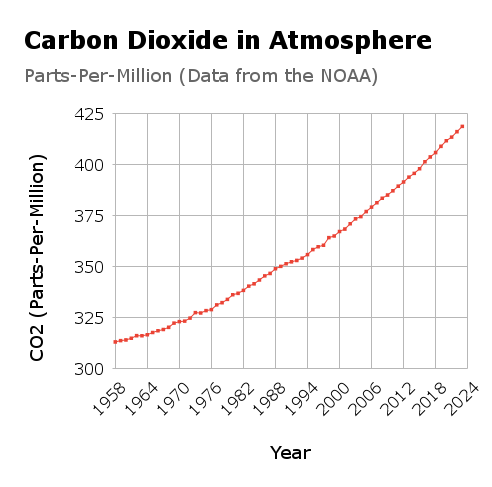WHAT ARE GREENHOUSE GASSES?
Greenhouse gasses are gasses that are able to trap heat in Earth’s atmosphere. Although many of these gasses exist naturally in Earth’s atmosphere, mass-deforestation and burning fossil fuels have caused these gasses to be much more prevalent beyond their natural levels. Some prominent greenhouse gasses in our atmosphere include carbon dioxide, methane, nitrous oxide, and water vapor.12
WHY ARE THESE CONCERNING?
These gasses are dangerous not only because they have the ability to trap heat in our atmosphere, but because they stay in the atmosphere for a long time. For instance, although water vapor is a very potent and widespread greenhouse gas, it only stays in the atmosphere for days at a time before coming down as rain. Human-produced greenhouse gasses on the other hand stick around for much longer. On average, methane sticks in our atmosphere for roughly 10 years, nitrous oxide for 121 years, and carbon dioxide for an average of a massive 650 years. These long-lasting greenhouse gasses are able to cause much more damage to our ecosystem because they are around to cause damage for a longer time.12
Although all of the aforementioned human-contributed gasses exist naturally in the atmosphere, even without our involvement,through deforestation and burning fossil fuels we have increased the levels of these gasses in our atmosphere far beyond natural levels. Research from NASA has concluded that carbon dioxide levels have risen by 50% in the last 200 years15, as well as nitrous oxide increasing by 18% in the past 100 years.17 It is also estimated that roughly 60% of the methane in our atmosphere was produced as a result of human activities.14
Together, humanity can work to reduce greenhouse gas emissions and air pollution, creating an efficient & clean world.12

Lan, Xin. “CO2 Atmospheric Data from 1958 to 2024.” NOAA Global Monitoring Laboratory, 5 Apr. 2024, gml.noaa.gov/webdata/ccgg/trends/co2/co2_mm_mlo.txt. Accessed 25 Apr. 2024.
GREENHOUSE GASSES RISING
With all of these greenhouse gasses are running rampant in our atmosphere, it's not a surprise that it is estimated that the earth could warm anywhere from 3.6-7.2ºF by the year 2100. Although this doesn’t seem like much, this is easily enough to make many species on earth face extinction, and make extreme weather more common19. In summary, rising temperatures would cause massive and even potentially irreversible effects to our ecosystem.
Renewable energy sources are a great alternative to fossil fuels. Instead of using gasses to burn fuel to power a generator, renewable energy sources use the elements of nature around them to provide power. This leads to renewable energy sources producing little to no greenhouse gasses, making them sustainable for energy production. Overall, renewable energy sources are a safe and long-term solution for generating energy. 12, 14
